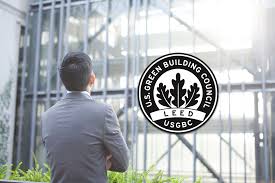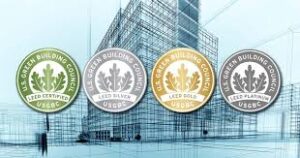
At a time of high energy costs and environmental concerns, commercial buildings face pressure to deliver increased efficiency, a low carbon footprint and healthy indoor air.
LEED certification is one way to make progress toward these goals. Established by the U.S. Green Building Council (USGBC), the Leadership in Energy and Environmental Design program is the globally recognized standard for eco-friendly design. LEED certification can be earned for the construction and operation of commercial buildings, and for professionals in relevant industries. According to the USGBC, the LEED standards help organizations achieve the triple bottom line of benefitting people, the planet and profits.
Mid America Specialty Services has a long track record of helping commercial buildings attain and maintain LEED status. We train and employ LEED-accredited professionals in the areas of metal, stone, wood and glass refinishing, along with facade restoration. We choose low-VOC products and sustainable materials for all projects whenever feasible, and we emphasize eco-friendly processes and practices.
How Does LEED Work?
The LEED program recognizes achievements in multiple areas, which promotes a whole-of-building approach to sustainability. Besides energy efficiency, certification criteria also focus on water savings, selection of building materials, reduction of waste and indoor environmental quality.
Certification includes a set of prerequisites and credits.
- Prerequisites are elements that must be included in order for a project to receive LEED certification.
- Credits are optional elements that also count toward certification.
Prerequisites and credits are organized into a broad range of categories including energy, water, materials, resources and indoor environmental quality.
Benefits of LEED Certification
The LEED program benefits stakeholders in the areas of building design, construction and operations by supporting sustainable and healthy practices. It encourages the development and use of innovative technologies and smart selection of materials. In addition to reducing environmental impact, LEED-compliant buildings often enjoy lower operating costs, increased value and a healthier indoor environment for employees and visitors.
LEED-compliant operations include the use of toxin-free materials and products for cleaning and architectural restoration. Not only does this keep surfaces looking their best, it may also promote higher productivity and reduce respiratory symptoms among building occupants.
LEED for Building Professionals
LEED certification isn’t just for construction projects and building operations. Professionals who work in these industries can earn LEED credentials to signify their expertise in green building standards.
More than 203,000 professionals have earned the LEED designation, including some of our customers at Mid America. The LEED credential demonstrates knowledge of sustainable techniques and products and may include design, construction and operation standards.
LEED for Existing Buildings
For buildings that have been operational and occupied for at least one year, LEED certification can be achieved for renovation projects, as well as day-to-day operations and maintenance. This provides an incentive for older buildings to “green up” for better efficiency and indoor environmental quality.
LEED standards for Operations and Maintenance apply to whole buildings and interior spaces that serve commercial, retail or hospitality functions. Prerequisites for renovations and maintenance activities include reducing environmental harm stemming from materials purchased, installed and disposed of in the course of a project. Buildings must also reduce harms associated with products purchased for operations and maintenance activities.
Green cleaning requirements for LEED certification help to reduce contaminants which may compromise human health, building finishes and the environment. To achieve this prerequisite, cleaning products must meet minimum published environmental standards.
LEED-compliant paints and coatings used in refinishing processes must also not exceed VOC content limits. Examples include products used on walls and ceilings, anti-corrosive or anti-rust coatings applied to metal substrates and finishes applied to architectural wood.
LEED for New Construction & Renovations
Mid America provides refinishing services for new construction of commercial buildings, as well as restoration work for renovations and historic preservation projects.
LEED certification may be earned for construction and renovations for commercial buildings, as well as for schools, retail facilities, data centers, warehouses and distribution centers, healthcare facilities and hospitality organizations such as hotels and resorts. To qualify for LEED status, at least 60% of a project’s gross floor area must be complete by the time of certification.
If you’re looking to restore the beauty and value of your architectural surfaces while maintaining a healthy building environment, the experts at Mid America are here to help.
You can reach us at 800-544-4576 or contact us online.
